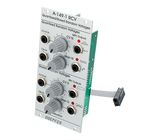I bought this unit, having heard other random voltage generators from other brands. I was attracted to the A-149 because it seemed simpler in operation, while retaining the main features I wanted from a 'Source Of Uncertainty' as these devices are sometimes called.
It is two units in one. The first, Quantised Random Voltages, can generate random octave or semitone ranges. Each of these is available from its own output. You can select the range of these manually, and then extend that using control voltage.
The second, Stored Random Voltages, generates 256 pitches (I think quarter tones). Again there are two outputs here. The first gives you a fixed even probability distribution of note pitch and is not alterable. The second lets you manually concentrate the probability either side of the mid-point. So you could have far more low notes, far more high notes, or (with the control in the middle) even probability across the range of notes generated.
The Fixed probability output is not CV controllable, while the variable probability output is.
The A-149-1 has a partner unit, the A-149-2. This generates 8 random gate signals, and could be used to trigger sequences, envelopes, or anything else which responds to a gate signal at its input.
While I find the A-149 very useful units own, I am planning to purchase an A-156 (again from Thomann!). This is a scale quantiser, which has two separate sections. The first section can take voltage on its input and output semitones. So for instance, a slow LFO sweep could be transformed into into a range of distinct notes that rise and fall with the LFO speed. The second section constrains input voltages in different ways. You can restrict notes to play arpeggios based on specific chords, or a particular key. This second option is controllable with CV.
The A-156 seems a natural partner to the A-149, and will extend the A-149's potential even further.


